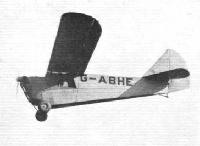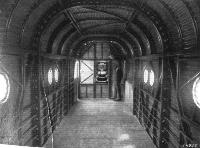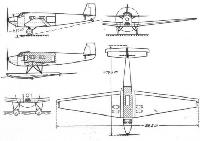Фотографии
-
"CAMEL-FLAGED": We are indebted to Mr. Grenville G.O. Manton for this photograph of a Sopwith "Camel," until recently his property, which he had modified somewhat. It was fitted with a 40-45 h.p. Anzani engine, and flew quite satisfactorily, though naturally, with a greatly reduced performance.
Самолёты на фотографии: Sopwith Camel / F.1 - Великобритания - 1916
-
THE Do.X AT LISBON: A reader sends us the "snaps" of the Do. X beached for repairs.
Самолёты на фотографии: Dornier Do.X - Германия - 1929
-
Регистрационный номер: G-AACJ THE ARMSTRONG-WHITWORTH "ARGOSY": Since 1926 this has been the machine to do most of Imperial Airways' landplane work. The engines are Armstrong-Siddeley "Jaguars."
Самолёты на фотографии: Armstrong Whitworth Argosy - Великобритания - 1926
-
Регистрационный номер: G-ABGK Lt. Comdr. Glen Kidston (left) with his Lockhead "Vega" monoplane (450 h.p. Pratt and Whitney "Wasp") which he "tried out" at Croydon last week. Lt. Cathcart Jones also took a turn at the "stick." Note, from the two views on the right, the N.A.C.A. cowling and the very neat metal monocoque fuselage.
Самолёты на фотографии: Lockheed Vega - США - 1927
-
Регистрационный номер: J9834 LE RENARD METALLIQUE: The Fairey all-metal "Fox" with Rolls-Royce F type engine is a high performance bomber. Its excellent qualities have received recognition recently in the form of substantial orders from the Belgian Government. The machines for Belgium will be almost identical with the British version shown here.
Самолёты на фотографии: Fairey Fox - Великобритания - 1925
-
Самолёты на фотографии: Gloster Gauntlet - Великобритания - 1929
-
Регистрационный номер: J9125 THE GLOSTER S.S.19. OR MULTI-GUN MACHINE IS ARMED WITH NO LESS THAN 6 MACHINE GUNS
J9125 as the SS.19, fitted with six 0-303in machineguns. Two Vickers guns were carried in the fuselage and two Lewis guns were located under the top and bottom wings.Самолёты на фотографии: Gloster Gauntlet - Великобритания - 1929
-
Регистрационный номер: G-AAWA The Westland "Wapiti," Mark V, G-AAWA, fitted with an Armstrong Siddeley "Panther," which has been sent out to South America to give demonstrations.
Самолёты на фотографии: Westland Wapiti - Великобритания - 1927
-
THE SECONDARY ASSEMBLY LINE: In this, which is 100 ft. long, there is room for four "Wapiti" Fuselages.
Самолёты на фотографии: Westland Wapiti - Великобритания - 1927
-
THE FINAL ASSEMBLY LINE: Small castor wheels are fitted on the axles to enable the machines to be moved sideways or forward.
Самолёты на фотографии: Westland Wapiti - Великобритания - 1927
-
THE BREDA 19: A single-seater biplane lor high aerobatic work, powered with 200 h.p. Armstrong Siddeley "Lynx."
Самолёты на фотографии: Breda Ba.19 / Ba.25 / Ba.28 - Италия - 1930
-
Регистрационный номер: G-AAGX THE HANDLEY-PAGE "HANNIBAL": Fitted with 4 Bristol "Jupiter" engines, this machine, which was designed to carry 42 passengers, is intended for the European and Cairo-Karachi sections of the Empire air routes next summer.
Самолёты на фотографии: Handley Page H.P.42 / H.P.45 - Великобритания - 1930
-
LOAD-TESTING THE "PUSS MOTH": These two photographs show a "Puss Moth" wing being loaded up with shot and, in the upper picture, supporting a load of 4,530 lb. A few seconds after this photograph was taken the wing collapsed. The factor required is 5 1/2, and this was actually slightly exceeded.
Самолёты на фотографии: De Havilland Puss Moth / D.H.80 - Великобритания - 1929
-
THE CANADIAN VICKERS "VANCOUVER," MARK II: A metal-hull flying boat accommodating six passengers and two pilots. Two Canadian Wright J-6 300-h.p. engines are fitted as standard, but Armstrong Siddeley "Lynx" engines can also be fitted.
Самолёты на фотографии: Canadian Vickers Vancouver - Канада - 1929
-
Регистрационный номер: G-ABHE [2] The little American Aeronca - or "Flying Wigwam" - flying at Croydon.
Самолёты на фотографии: Aeronca C - США - 1929
-
Регистрационный номер: G-ABHE [2] A "FLY-WEIGHT" MACHINE: Mr. S. A. Thorn ready to take off in Col. Ormonde Darby's Aeronca.
Самолёты на фотографии: Aeronca C - США - 1929
-
THE FATAL STROKE! Mrs. Taylor photographed just after striking the fatal blow! Mr. Allen, of Henly's, evidently thinks his aircraft worth such an anointing.
Самолёты на фотографии: Avro Avian / Type 594/616 - Великобритания - 1926
-
AFTER THE BAPTISM The B.P. (Jo.'s new Avian (Hermes II) ready for business.
Самолёты на фотографии: Avro Avian / Type 594/616 - Великобритания - 1926
-
FOR THE BUENOS AIRES EXHIBITION: This Avro "Avian" , "Cirrus-Hermes" II engine, has been shipped to Argentina, where it will be used for demonstration flights at El Palomar aerodrome.
Самолёты на фотографии: Avro Avian / Type 594/616 - Великобритания - 1926
-
One of the three-engined Ford airliners, employed by National Air Transport (Inc.) of America, with the ingenious wing mail compartments.
Самолёты на фотографии: Ford Tri-Motor / 4-AT / 5-AT - США - 1926
-
How the mails are placed in the ingenious wing mail compartments is shown in the top picture, while the lower picture shows an interior view of the compartment.
Самолёты на фотографии: Ford Tri-Motor / 4-AT / 5-AT - США - 1926
-
Mrs. Victor Bruce’s long-distance Bluebird in which she flew 19,000 miles arrives at Croydon.
Самолёты на фотографии: Blackburn Bluebird / L.1 - Великобритания - 1924
-
EN ROUTE FOR THE CAPE: Miss Reynolds and Mr. Pudney, who will shortly be flying to the Cape by the west coast route in the first Bluebird to be fitted with a Gipsy III engine.
Самолёты на фотографии: Blackburn Bluebird / L.1 - Великобритания - 1924
-
THE "FLYING CARPET": Two americans, from California, Moye Stephens and Richard Halliburton, are carrying out a tour round the World in his Spearman biplane, fitted with a Wright "Whirlwind" engine. They arrived in this country with their machine, by boat, last week and flew to Heston Air Park on February 10. It is probable that they will resume their tour from Heston today - Friday - and they expect to complete their journey in two years.
Самолёты на фотографии: Stearman C1 / C2 / C3 / 4E / 6 Cloudboy - США - 1927
-
FOR THE AFRICAN AIR ROUTE: The "AW. XV" four-engined monoplane, which is being built for Imperial Airways by Armstrong-Whitworth, Ltd. It has four Armstrong-Siddeley "Double-Mongoose" engines.
Самолёты на фотографии: Armstrong Whitworth Atalanta / A.W.15 - Великобритания - 1932
-
THE "ISLAND" ABEAM: A Fairey IIIF taking off from the deck of H.M.S. "Glorious".
We are looking forward at a Fairey III F which is just taking off away from us. This view shows very clearly that, although the III F has a comparatively large span, she still has plenty of room when abreast the funnel or island, as it is called in this craft.Самолёты на фотографии: Fairey Fairey IIIF - Великобритания - 1926
-
Регистрационный номер: S1316 CATAPULT LAUNCHING OF AIRCRAFT: This photograph of a Fairey III F seaplane being catapulted off is reproduced by courtesy of the Admiralty.
Fairey IIIF Mk IIIM S1316 being launched from a Mactaggart Scott catapult in 1931.Самолёты на фотографии: Fairey Fairey IIIF - Великобритания - 1926
-
A SUCCESSFUL FRENCH LIGHT 'PLANE: The Farman F. 230, with 45-h.p. Salmson, which is another version ot the F.231 (100-h.p. Renault), on which Lalouette and de Permangle established the light 'plane long-distance record recently.
Самолёты на фотографии: Farman F.230 / F.350 - Франция - 1930
-
Регистрационный номер: I-AAVR The first A.S.2 light 'plane used by the three Italian pilots in their flight round Africa.
Самолёты на фотографии: FIAT AS.1 / AS.2 / TR.1 - Италия - 1928
-
Регистрационный номер: G-AAND ABOVE WINDSOR CASTLE: A remarkable view of the Castle with the River Thames in the background. The machine is a Hermes-engined Desoutter belonging to National Flying Services.
Самолёты на фотографии: Koolhoven FK-41 - Нидерланды - 1928
-
THE NEW FOKKER F.XII: Taxying out for a Demonstration flight at Croydon.
Самолёты на фотографии: Fokker F.IX / F.XII / F.XVIII - Нидерланды - 1929
-
FRONT VIEW OF FOKKER F.XII: The Pratt & Whitney "Wasps" are neatly arranged.
Самолёты на фотографии: Fokker F.IX / F.XII / F.XVIII - Нидерланды - 1929
-
Регистрационный номер: PH-AFL [2] The Fokker F.XII taking up passengers at Croydon.
Самолёты на фотографии: Fokker F.IX / F.XII / F.XVIII - Нидерланды - 1929
-
Регистрационный номер: PH-AFL [2] THE FOKKER F.XII: Side view. Note the length of fuselage in proportion to wing chord.
Самолёты на фотографии: Fokker F.IX / F.XII / F.XVIII - Нидерланды - 1929
-
The Hawker "FURY" Interceptor Fighter with Rolls-Royce "F" Engine has been selected for R.A.F. equipment after extensive competitive trials - further proof of the all-round superiority of Hawker aircraft.
Самолёты на фотографии: Hawker Hornet / F.20/27 - Великобритания - 1928
-
The all-metal Junkers Ju.52 which with the B.M.W. VII, 700 h.p. engine has a payload of 4,680 1b. with a 622-mile range or 3,210 lb. when the range is increased to 1,244 miles. Mr. McDonough opines that the low-wing type will not be so easy to load as the high-wing type when on floats - an important point under N.W. Canadian conditions.
Three-quarter front view which shows the mounting of the wing flaps, giving a species of slot effect over them.Самолёты на фотографии: Junkers Ju.52/1m - Германия - 1930
-
View showing the side and top batches for loading. The metal floor of the cabin is covered with 3-ply wood, and in the space between that and the bottom are the lockers for valuable goods.
Самолёты на фотографии: Junkers Ju.52/1m - Германия - 1930
-
An interior view of the cargo space.
Самолёты на фотографии: Junkers Ju.52/1m - Германия - 1930
-
Самолёты на фотографии: Junkers Ju.52/1m - Германия - 1930
-
Регистрационный номер: G-ABFA A WONDERFUL NEW FLYING BOAT: The first of the Short "Kent" class, to be named "Scipio," was launched at Rochester on February 24, and made a perfectly successful test flight, piloted by Mr. Lankester Parker. The machine, which is equipped with four Bristol geared and medium supercharged "Jupiters," is one of three ordered by Imperial Airways.
Самолёты на фотографии: Short Kent / S.17 - Великобритания - 1931
-
Three-quarter rear view of the "Scud" glider.
Самолёты на фотографии: Abbott-Baynes Scud - Великобритания - 1931
-
Two views of the Baynes "Scud" making its one-hour flight at Dunstable.
Самолёты на фотографии: Abbott-Baynes Scud - Великобритания - 1931
-
Mr. I. Mole (left) who put up a flight of 1 hr. 2 min. on the "Scud" Intermediate glider which was designed by Mr. L. E. Baynes (right).
Самолёты на фотографии: Abbott-Baynes Scud - Великобритания - 1931
-
The Brant "Scud"
Самолёты на фотографии: Abbott-Baynes Scud - Великобритания - 1931
-
AN AMERICAN TWO-SEATER GLIDER: This machine was designed by the Leonard Motorless Aircraft Corp. for dual instruction. The fuselage is of steel tube construction.
Самолёты на фотографии: Leonard Motorless Aircraft 2 seater - США - 1930
-
THE "FALCON FOUR": Two views showing the machine in flight. The engines are Hermes II's. The machine is being built to the order of the Hon. Mrs. Freeman-Thomas.
Самолёты на фотографии: Henderson, Miles Falcon Four - Великобритания - 1931
-
Регистрационный номер: 623V The Curtiss-Wright Junior" (40 h.p. Szekeley engine.)
Самолёты на фотографии: Curtiss-Wright CW-1 Junior / CR-1 Skeeter / CW-3 Duckling - США - 1930
-
Mr. S. W. Vine and his sailplane.
Самолёты на фотографии: Vine glider - ЮАР - 1930
Статьи
- Flight















































